Abstract
Chemical sensors, relying on electrical conductance changes in a gas-sensitive material due to the surrounding gas, have the (dis-)advantage of reacting with multiple target gases and humidity. In this work, we report CMOS-integrated SnO2 thin film-based gas sensors, which are functionalized with mono-, bi-, and trimetallic nanoparticles (NPs) to optimize the sensor performance. The spray pyrolysis technology was used to deposit the metal oxide sensing layer on top of a CMOS-fabricated micro-hotplate (µhp), and magnetron sputtering inert-gas condensation was employed to functionalize the sensing layer with metallic NPs, Ag-, Pd-, and Ru-NPs, and all combinations thereof were used as catalysts to improve the sensor response to carbon monoxide and to suppress the cross-sensitivity toward humidity. The focus of this work is the detection of toxic carbon monoxide and a specific hydrocarbon mixture (HCmix) in a concentration range of 5–50 ppm at different temperatures and humidity levels. The use of CMOS chips ensures low-power, integrated sensors, ready to apply in cell phones, watches, etc., for air quality-monitoring purposes.
1. Introduction
Gas sensing has become a vital necessity for ensuring high air quality (AQ) indoors and outdoors. Since people in Europe spend 90% of their time indoors, environmental monitoring is of tremendous importance for private homes, offices, and vehicles. Poor indoor air quality has a great impact on human health (allergies, asthma, cancer, etc.) and also on employee productivity (15% reduction by low indoor air quality) [1]. Air pollution is considered a “silent killer”, causing an estimated 7 million premature deaths every year [2]. Hence, it is crucial to monitor precisely and improve the quality of the air inside buildings. The State of the Art in the identification of gas species is lab-class analytical techniques, such as infrared spectroscopy, fluorescence spectroscopy, chemiluminescence, gas chromatography, or mass spectroscopy. While these lab-based technologies are very effective, all of these techniques are based on bulky and expensive tools, which are limited to stationary use and not suited for applications such as miniaturized handheld technologies, consumer electronic devices, or Internet-of-Things-based sensor networks [3].
In practice, air quality monitoring can be performed by gas sensor devices, which can be categorized into five main types according to their operational principle [4]: electrochemical (redox reactions on the electrodes), catalytic (burning of gas molecules), non-dispersive infrared (absorption of IR radiation), photo-ionization (gas ionization by UV-light), and solid-state (absorption/desorption of oxygen molecules from metal oxide (MOx) surface) [5]. The last type is a conductometric MOx-based gas sensor which has many advantages: it is highly sensitive to many dangerous gases, stable in an oxygen atmosphere, and has a long lifetime [6]. Over the past decades, various types of MOx-based sensors have been developed [7,8,9,10]. Among those, sensors based on MOx, such as SnO2, ZnO, CuO, TiO2, and WOx [11,12], are the most promising candidates for inexpensive, compact implementations with industrial relevance [13,14,15,16,17,18]. Nevertheless, MOx-based gas sensors have significant drawbacks, because they suffer from cross-sensitivity issues and require a comparatively high operation temperature, which results in high power consumption being necessary to operate the sensor [19]. These drawbacks have prevented their mass market penetration in consumer electronics, in particular, for ultralow-power applications (e.g., energy autonomous IoT devices) [20,21].
There are several approaches to overcome these disadvantages and improve the performance of gas sensor devices: Sensitivity can be improved by the implementation of nanomaterials, such as nanocrystalline thin films, nanowires, or NPs, to maximize the surface to volume ratio [22,23,24]. The use of specific MOx nanostructures has demonstrated a general improvement in the gas-sensing performance. Selectivity can be improved by dedicated functionalization of MOx nanostructures with metallic NPs [25,26,27,28,29], which provide a catalytic effect. Moreover, this kind of functionalization can lead to improved sensitivity, which enables a lower sensor operation temperature as compared to the basic device. High power consumption can be minimized by using micro-hotplate devices; integration of sensing materials on CMOS technology-fabricated micro-hotplates allows us to fabricate advanced gas-sensing devices with low power consumption and give us the potential to integrate them into everyday electronic devices [20,21,30].
In the literature, the enhanced influence of metallic nanoparticles on the sensing performance of MOx-based sensors has already been widely investigated. However, a systematic study of different types of metallic nanoparticles and all their bi- and tri-metallic combinations has never been reported, especially not on CMOS-integrated chips. In this work, we demonstrate that the performance of CMOS-integrated SnO2 thin film-based gas sensors can be significantly improved via functionalization with mono-, bi-, and trimetallic nanoparticles (NPs). Ag-, Pd-, and Ru-NPs and all combinations thereof have been deposited by magnetron sputtering inert-gas condensation on the SnO2 films. This article focuses on the efficient detection of the toxic gas carbon monoxide (CO) in a humid atmosphere (50% relative humidity level) in a concentration regime between 5 ppm and 50 ppm, which is in the range of the maximum allowed concentration in the workplace in Germany (30 ppm [31]), and hence, it highly relevant for practical safety applications. In order to mimic cross-sensitivity toward Volatile Organic Compounds (VOCs), a specific mixture of hydrocarbon gases (HCmix, mixture of acetylene, ethane, ethene, and propene, each of them 500 ppm) was investigated as well. We demonstrate that surface functionalization with mono-, bi-, and trimetallic NPs strongly improves the sensor in particular in the low operation temperature range between 100 °C and 200 °C, where the bare SnO2 film exhibits no significant response. The idea is to find materials for optimizing the selectivity of a gas sensor system by increasing and decreasing the sensitivity of SnO2 toward CO and HCmix, respectively.
2. Materials and Methods
2.1. Fabrication of Sensor Devices
For this work, a CMOS-based sensor chip (ams OSRAM AG, Premstätten, Austria) with 8 micro-hotplates (µhps) [30] was used. Each µhp has two sensors, leading to a total of 16 sensors on one sensor chip. The µhps are based on a poly-Si heater and are etched through the CMOS stack down to the bulk Si. The sensors are contacted with Ti (5 nm)/Pt (150 nm) electrodes for a 4-point measurement.
The base sensing material is a SnO2 thin film (thickness, 50 nm), which was deposited with spray pyrolysis technology at atmospheric pressure. The precursor solution was a tin chloride pentahydrate (SnCl4·5H2O) in ethyl acetate. The solution was sprayed with a N2 carrier gas on the chips, which were kept at 400 °C during the spraying process. The chips were annealed at 400 °C for 60 min for a more homogenous surface structure. The sensing films were structured by a photolithography process and dry Ar ion etching. Next, the films were coated with a resist protection layer before the µhps were under-etched by an isotropic XeF2 dry-etching process. The finished chips were cleaned from the protective layer and further processed by stealth dicing into single dies (4.7 × 5.1 mm2), which were glued and wire-bonded to printed circuit boards for the gas measurements. Figure 1a shows the final CMOS-integrated chip with 8x µhp array, and Figure 1b shows a single µhp with two SnO2 sensor structures.
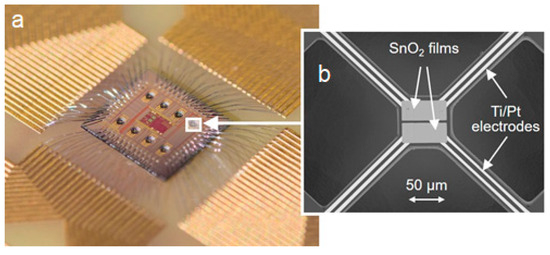
Figure 1.
(a) Micro-hotplate chip and (b) single µhp.
The next step was the functionalization of the SnO2-based chips with NPs; it was achieved by magnetron sputtering inert-gas condensation in a high-vacuum system using a cluster beam source, followed by an in-line quadrupole mass filter (QMF) for size selection [32]. For the generation of NPs, the NanoGen Trio deposition system (Mantis Deposition Ltd., Thame, UK), was employed, which features the possibilities of either sequential sputtering or co-sputtering in parallel up to three independent targets. Since the current study already contained a great number of variable parameters (metallic element, number of elements, detected gases, gas concentration range, humidity level, and temperature), we used sequential sputtering of the individual elements to keep it simple. The sputtering sequence should have no impact on the sensing performance, because the amount of each metal was controlled by the time of the individual sputtering steps. Hence, the analysis is focused on size distributions and coverages (NP number/area) for the multi-element cases. High-resolution TEM images of the individual-element NPs are presented, which should be representative NP structures for all cases (no alloying, no segregation, and only minor surface coalescence at this coverage). The base pressure was ~10−8 mbar before deposition, whereas the pressures were ~10−4 mbar and ~10−1 mbar in the main chamber and the aggregation zone, respectively, during NP deposition. The argon-gas flow rate was set at 70 sccm, and the aggregation zone length was fixed at 120 mm. A 5 W power was applied to the Ag, Pd, and Ru targets during sputtering in order to produce mono-metallic (Ag, Ru, and Pd), mixed bi-metallic (AgRu, AgPd, and RuPd), and mixed tri-metallic (AgRuPd) NPs. The substrate was rotated at 2 rpm to obtain a more uniform coverage. NPs were characterized in terms of crystalline structure and size using a FEI Titan G2 Environmental TEM (operation voltage 300 kV):
- The monometallic Ru-NPs exhibit a monocrystalline hcp structure, and some degree of surface faceting is observed—see Figure 2a. The size distribution, as determined from 540 NPs, is in the range from 1 to 5 nm, with an average size of 2.5 nm—as shown in Figure 3d;
 Figure 2. High-resolution TEM investigation of (a) Ru NP, (b) Ag NP, and (c) Pd NP.
Figure 2. High-resolution TEM investigation of (a) Ru NP, (b) Ag NP, and (c) Pd NP.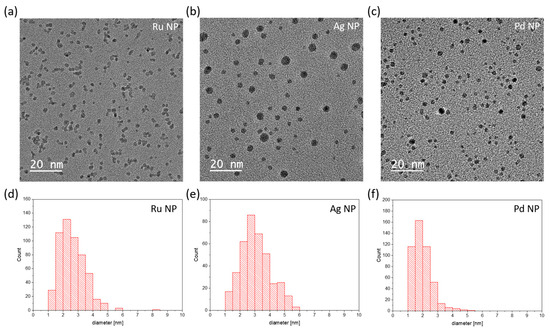 Figure 3. TEM investigation of (a) Ru NP, (b) Ag NP, and (c) Pd NP and the size distribution of (d) Ru NP, (e) Ag NP, and (f) Pd NP.
Figure 3. TEM investigation of (a) Ru NP, (b) Ag NP, and (c) Pd NP and the size distribution of (d) Ru NP, (e) Ag NP, and (f) Pd NP.
- The size distribution for bimetallic PdRu-NPs, as determined from 613 NPs, is in the range from 1 to 5 nm, with an average size of 2 nm, as shown in Figure 4d;
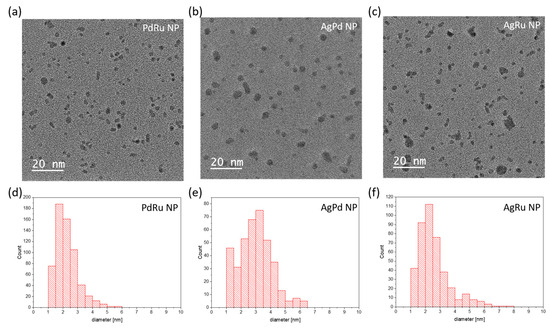 Figure 4. TEM investigation of (a) PdRu NP, (b) AgPd NP, and (c) AgRu NP and the size distribution of (d) PdRu NP, (e) AgPd NP, and (f) AgRu NP.
Figure 4. TEM investigation of (a) PdRu NP, (b) AgPd NP, and (c) AgRu NP and the size distribution of (d) PdRu NP, (e) AgPd NP, and (f) AgRu NP. - The size distribution of bimetallic AgPd-NPs, as determined from 390 NPs, is in the range from 1 to 5 nm, with an average size of 3.5 nm, as shown in Figure 4e;
- The size distribution of bimetallic AgRu-NPs, as determined from 423 NPs, is in the range from 1 to 6 nm, with an average size of 2.5 nm, as shown in Figure 4f;
- The size distribution of trimetallic AgRuPd-NPs, as determined from 423 NPs, is in the range from 1 to 6 nm, with an average size of 2.5 nm, as shown in Figure 5b.
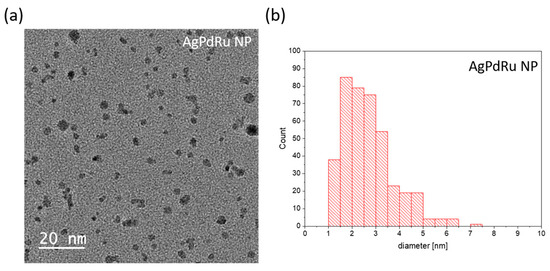 Figure 5. TEM investigation of (a) AgPdRu NP and the size distribution of (b) AgPdRu NP.
Figure 5. TEM investigation of (a) AgPdRu NP and the size distribution of (b) AgPdRu NP.
2.2. Characterization of the CMOS-Based Sensors
The performance of the CMOS-based sensors employing bare SnO2 films and SnO2 films functionalized with mono-, bi-, and trimetallic NPs was analyzed in an automated gas measurement setup. The sensing layers were not annealed at elevated temperatures (e.g., 400 °C) before the gas measurements to prevent potential migration and agglomeration or even melting of the NPs on the surface of the SnO2 films [33]. Usually, we test our sensors also at higher temperatures up to 400 °C, because their response is usually maximum around 350 °C. However, many previous experiments have shown that the NPs can significantly change at temperatures above 150 °C in terms of morphology, agglomeration, and diffusion into the substrate, which has a negative impact on sensor response. Therefore, to ensure reproducibility and comparability between the different types of NPs, we strictly limited the operation temperature to a maximum of 200 °C. The gas chamber was a stainless-steel box with a volume of 80 cm3 for gas flow and additional integrated electronics for operating the sensors. The operation temperature of the gas sensors was controlled by thermocouples, which are integrated into the CMOS stack of each µhp. The total gas flow was controlled by mass flow controllers and set to 1 l/min, and the humidity level was achieved by a water bubbler and feedback loop controlled by a commercial humidity sensor (AFK-E, KOBOLD Messing GmbH, Hofheim am Taunus, Germany). A python program was implemented to enable the automatic control of the gas measurement setup.
In this study, we focused on the toxic gas CO and the HCmix. The HCmix, consisting of four different gas components (acetylene, ethane, ethene, and propene), is a representative mixture of VOCs. Both test gases are indicators of air pollution. The main focus here is the influence of metallic nanoparticles on the sensitivity and selectivity toward CO and HCmix. Synthetic air (80% nitrogen and 20% oxygen mixture) was used as background gas, whereas the CO and HCmix test gases are mixtures in N2. All gases are ready-to-use mixtures from Linde Gas Austria. Test gas concentrations were 5 ppm, 25 ppm, and 50 ppm. The sensor response was calculated as follows:
where Rgas represents the resistance measured at the saturation point of the gas pulse, and Rair denotes the resistance in pure synthetic air. Consequently, the resistance trend in the background gas could be determined, and Rair was established based on this trend.
3. Results and Discussion
The different functionalized sensors are tested toward CO and HCmix (mixture of acetylene, ethane, ethene, and propene, each of them 500 ppm). Our focus was on assessing the sensors’ sensitivity toward the two test gases and exploring the potential for suppressing the cross-sensitivity to humidity through NP functionalization. The gas-sensing measurements were performed at a 200 °C operation temperature. Figure 6 shows a typical resistance measurement of a SnO2 sensor at a 200 °C operation temperature and different humidity levels (25%, 50%, and 75%) for three different concentrations of CO (5 ppm, 25 ppm, and 50 ppm) gas pulses. The gas pulse duration was 5 min, and the recovery time after the gas pulse was set to 15 min. As is obvious from Figure 6, the resistance of the bare SnO2 sensors is strongly influenced by the humidity of the background gas. The highest resistance is measured at the lowest (25%) humidity level. The resistance at 75% is at the same magnitude as for 50% humidity. The response of the bare SnO2 sensors to CO significantly depends on the humidity, too (Figure 7). The highest response is observed at a 25% humidity level. The response decreases for 50% humidity, and it increases slightly for 75% humidity.
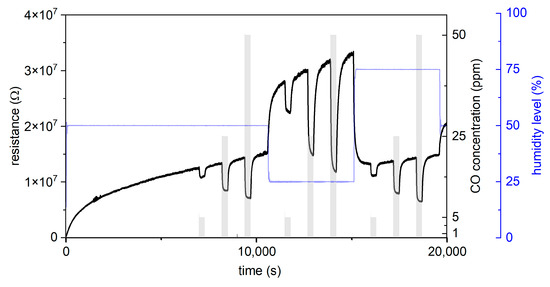
Figure 6.
Resistance measurement of a bare SnO2 sensor operated at 200 °C. The background gas has three different humidity levels: 50%, 25%, and 75%. At each humidity level, three CO gas pulses (duration 5 min) with 5 ppm, 25 ppm, and 50 ppm concentrations are introduced.
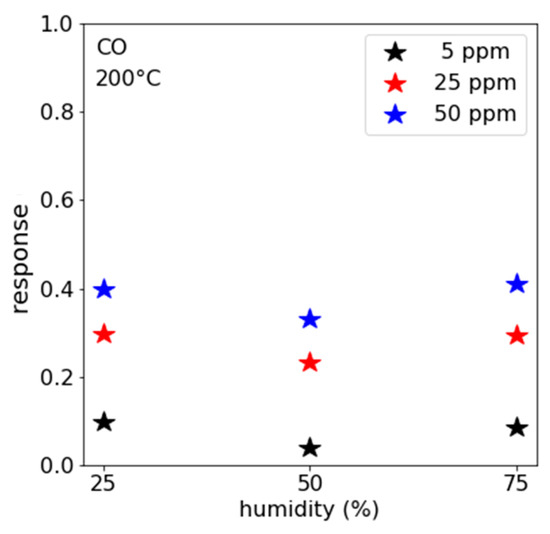
Figure 7.
Response of a bare SnO2 sensor at 200 °C operation temperature to three CO test gas pulses with 5 ppm (black), 25 ppm (red), and 50 ppm concentration (blue) at humidity levels of 25%, 50%, and 75%.
3.1. CO Measurements
In the initial phase of our investigation, we focused on the functionalization of the SnO2 sensor using monometallic nanoparticles (Ag, Pd, and Ru). The responses of these sensors to varying concentrations of CO were examined under different humidity conditions, with the bare SnO2 sensor serving as the reference. As illustrated in Figure 8, the response to CO increases with increasing CO concentration; however, the response does not show linear behavior. The sensitivity of sensors functionalized with monometallic NPs demonstrates a behavior closer to linearity compared to the bare sensor. Notably, both Pd and Ru monometallic NPs enhance the individual response to each CO concentration. The difference in the response between the functionalized and bare sensors becomes more pronounced with higher CO concentrations.
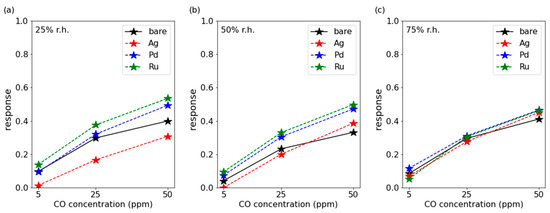
Figure 8.
Response of a bare SnO2 sensor (black) and SnO2 functionalized with monometallic Ag (red), Pd (blue), and Ru (green) NPs to different CO concentrations (5 ppm, 25 ppm, and 50 ppm) at different humidity levels ((a) 25%, (b) 50%, and (c) 75%).
The response of the sensor functionalized with Ag NPs at 25% rh is lower than the response of the bare SnO2 sensor but shows a linear increase with the CO concentration. Additionally, we observed that with increasing humidity, the response of the Ag-functionalized sensor converges with the response of bare SnO2 sensors.
Figure 9 illustrates the responses to CO of sensors functionalized with bimetallic AgPd-, RuPd-, and AgRu-NPs. Notably, the sensors functionalized with AgPd- and AgRu-NPs show the same nonlinear behavior as the bare SnO2 sensor. For 25% relative humidity, the RuPd-functionalized sensor shows a nearly linear behavior with increasing concentration of CO. For RuPd-NPs, the sensor response decreases with increasing humidity level. The AgPd-NP- and AgRu-NP-functionalized sensors exhibit a significantly reduced dependence on the humidity level, and the sensor response is almost independent of the humidity.
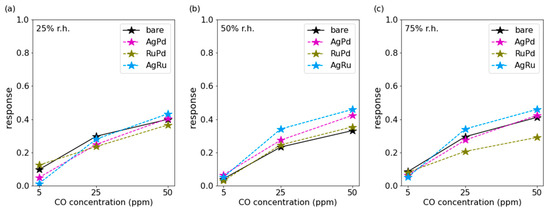
Figure 9.
Response of a bare SnO2 sensor (black) and SnO2-functionalized bimetallic AgPd, RuPd, and AgRu NPs to different CO concentrations (5 ppm, 25 ppm, and 50 ppm) at different humidity levels ((a) 25%, (b) 50%, and (c) 75%).
Figure 10 compares the best sensors from the monometallic (Ru), bimetallic (AgRu), and trimetallic (PdAgRu) NP-functionalized sensors. The sensitivity of the trimetallic NP shows a pronounced increase in the response already at low concentrations. The sensor functionalized with trimetallic NPs shows a nonlinear increase in the response as the concentration increases, representing the most notable enhancement observed in these sensors.
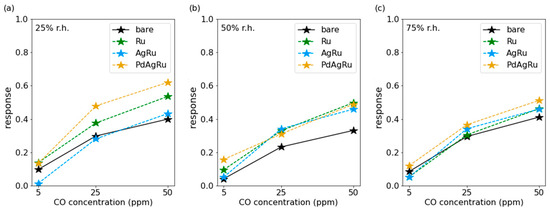
Figure 10.
Response of a bare SnO2 sensor (black) and SnO2 functionalized with Ru, AgRu, and PdAgRu NPs to different CO concentrations (5 ppm, 25 ppm, and 50 ppm) at different humidity levels ((a) 25%, (b) 50%, and (c) 75%).
In Figure 11, we focus on the cross-sensitivity to humidity of the bare SnO2 and the functionalized sensors for 50 ppm CO exposure. The bare SnO2 sensor shows consistent response at 25% and 75%, but a significantly lower response at 50% rh. In contrast, the sensors functionalized with monometallic NPs show a distinct linear dependence on the humidity. For Pd- and Ru-NPs, the responses decrease, and for Ag-NPs, the response increases with increasing humidity. The response of AgRu- and AgPd-NP-functionalized sensors is almost independent of the humidity; for RuPd-NPs, the response decreases with increasing humidity, and this observation is more pronounced at high humidity levels. The PdAgRu-NP-functionalized sensor exhibits the highest response of all sensors, as it decreases with increasing humidity, a response more pronounced for low humidity levels, and reaches saturation around 50%. The Ag-NP-functionalized sensor is unique, as its response increases with rising humidity. Most promising are the AgPd- and AgRu-NP-functionalized sensors, since the responses of these sensors appear nearly independent of the humidity level.
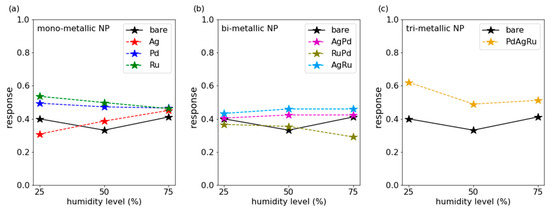
Figure 11.
Response of a bare SnO2 sensor (black) and SnO2 functionalized with (a) monometallic, (b) bimetallic, and (c) trimetallic NP-functionalized sensors to 50 ppm CO concentrations at different humidity levels (25%, 50%, and 75%).
3.2. HCmix Measurements
In the latter part of the work, our investigation focuses on the response of the same sensors to HCmix.
As depicted in Figure 12, both the bare SnO2 and all monometallic-functionalized sensors exhibited a clear increase in response correlating with the concentration of the HCmix. Notably, sensors with Ag- and Pd-NPs demonstrated a stronger increase in the response within the low concentration range up to 25 ppm, plateauing toward 50 ppm. This observation suggests saturation, which is seen across all three humidity levels. Conversely, the behavior of the Ru-functionalized sensors is close to one of the bare sensors.
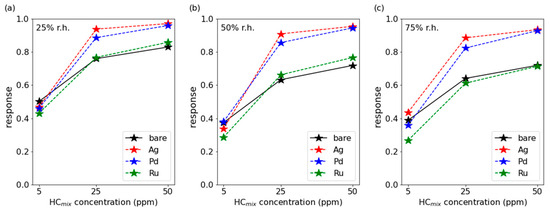
Figure 12.
Response of a bare SnO2 sensor (black) and SnO2 functionalized with monometallic NP to different HCmix concentrations (5 ppm, 25 ppm, and 50 ppm) at different humidity levels ((a) 25%, (b) 50%, and (c) 75%).
In Figure 13, the performance of bimetallic NP-functionalized sensors against HCmix concentration is shown. The responses of the bimetallic NP-functionalized sensors show the same behavior as the monometallic ones. However, the response increase is more pronounced with increasing concentration compared with that of the bare SnO2 sensor. In contrast to the monometallic ones, the individual responses are lower than the response of the bare sensor at low humidity levels. With increasing humidity levels, AgPd NP-functionalized sensors show a higher response than the bare sensor. The responses of the other bimetallic NPs increase, but they are still lower than for the bare SnO2 sensor.
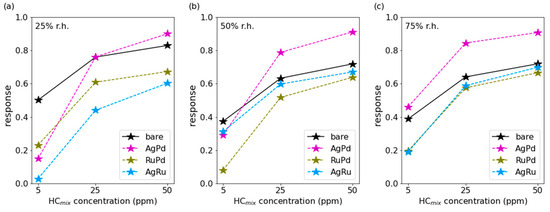
Figure 13.
Response of a bare SnO2 sensor (black) and SnO2 functionalized with bimetallic NPs to different HCmix concentrations (5 ppm, 25 ppm, and 50 ppm) at different humidity levels ((a) 25%, (b) 50%, and (c) 75%).
In Figure 14, we compare the best performing sensors from monometallic (Ag) and bimetallic (AgPd) with trimetallic (PdAgRu) NP-functionalized sensors across all three tested humidity levels. Both mono- and bimetallic sensors show a strong increase in response with concentration compared to the bare sensor and higher responses than the bare sensor. Conversely, the trimetallic NPs display a consistent dependence on concentration, even though they show slightly higher individual responses compared to the bare sensor.
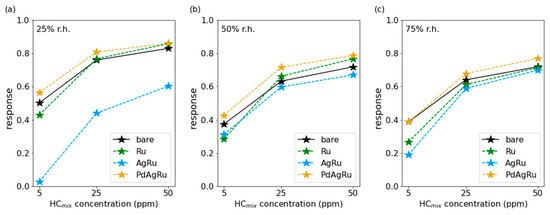
Figure 14.
Response of a bare SnO2 sensor (black) and SnO2 functionalized with Ru, AgRu, and PdAgRu NPs to different HCmix concentrations (5 ppm, 25 ppm, and 50 ppm) at different humidity levels ((a) 25%, (b) 50%, and (c) 75%).
Not only is the response to HCmix crucial for an optimized sensor, but also for ensuring minimal cross-sensitivity to humidity. In Figure 15, we illustrate the responses of optimized sensors for 50 ppm HCmix across three different humidity levels. The response of the bare sensor decreases from 25% to 50% humidity before it reaches saturation. The sensors with monometallic NPs display a decrease in response with increasing humidity, with slight decreases observed for Ag and Pd, and a more pronounced one for Ru. Sensors with RuPd-NPs show similar responses at 25% and 75% humidity levels, with a smaller response at 50%. Meanwhile, the response of the AgRu-NP-functionalized sensor increases with rising humidity, while the sensor with AgPd-NPs appears unaffected by humidity. Trimetallic-functionalized sensors have a response pattern similar to the bare sensor, indicating similar dependence on humidity.
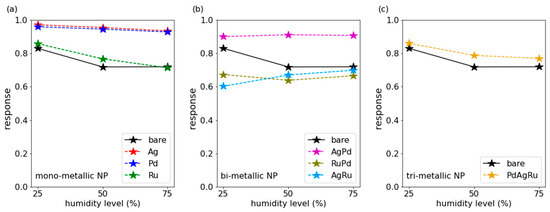
Figure 15.
Response of a bare SnO2 sensor (black) and SnO2 functionalized with (a) monometallic, (b) bimetallic, and (c) trimetallic NPs to 50 ppm HCmix concentrations at different humidity levels (25%, 50%, and 75%).
3.3. Discussion
The functionalization of sensors aimed at not only enhancing sensitivity toward specific test gases but also distinguishing between them. In Figure 16, we compare the performance improvement of the most promising NP-functionalized sensors with respect to the performance of the bare ones for both CO and HCmix at different humidity levels. The Ag-functionalized sensor exhibits a significant enhancement for HCmix across all three humidity levels (for 25% rh: increase about 20%; and for 50% rh and 75% rh: increase about 30%). On the other hand, for CO detection, Ag NPs reduce the response at a lower humidity level by about 20% but enhance it with higher humidity by about 20% (50% rh) and 10% (75% rh). Pd NPs amplify the response to both test gases, with Ru more prominently increasing the response to CO.
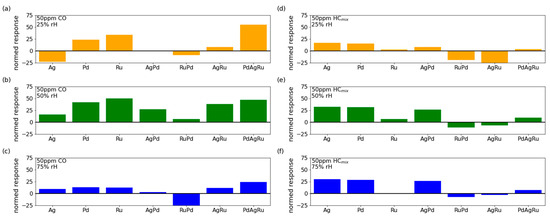
Figure 16.
Relative change in the responses of the functionalized sensors compared to the bare SnO2 for (a–c) 50 ppm CO and (d–f) 50 ppm HCmix concentrations at different humidity levels ((a,d) 25%, (b,e) 50%, and (c,f) 75%).
Among the bimetallic NPs, those with Ag show the most substantial improvement for CO and HCmix, respectively. The AgRu-functionalized sensors exhibit increased sensitivity to CO but markedly reduced sensitivity to HCmix compared to the bare sensor. For the AgPd-functionalized sensor, the improvement for CO and HCmix compared to the bare sensor is very similar. Trimetallic NPs enhance the response to CO, while the response to HCmix remains close to that of the bare sensor.
In our case, the Ag-NPs showed the most promising results regarding distinguishing CO and HCmix. The Ag NP-functionalized sensors significantly increase the response to the HCmix, but they have only a small impact on the CO response. A similar behavior was observed for an acetylene (part of our HCmix) sensor, which is based on Ag-loaded ZnO-reduced graphene; the sensor exhibited enhanced sensing toward C2H2 and decreased sensing toward CO at a 200 °C operating temperature. This behavior has been attributed to potential barriers formed by the chemisorbed oxygen ions on the ZnO surface, which prevents the C2H2 molecules from reacting. Ag catalytically activates the dissociation of molecular oxygen. Due to the spillover effect, more acetylene-sensing sites on the surface are created, consequently enhancing the sensor’s response. A similar behavior was reported for an acetylene sensor fabricated on a µhp chip using In2O3 as the sensing material with Pd–Ag core–shell NPs on top as catalysts, where the Ag triggers an increased response to acetylene. We assume that the Ag plays the same role in the case of our SnO2-based sensors and increases the sensor response to at least one of the four HCmix components. It is plausible that a similar mechanism also increases the response toward the other three HCmix components.
4. Conclusions
By combining different NP-functionalized sensors with a humidity sensor into a multisensor device, one can identify and detect concentrations ranging from 5 up to 50 ppm for both test gases, CO and HCmix. Regarding sensitivity to humidity, some promising candidates, like Pd and AgPd, demonstrate low cross-sensitivity to humidity while detecting both test gases. In contrast, the Ag- and AgRu-functionalized samples exhibit different responses to humidity and the two test gases. Therefore, this behavior can be used to identify the observed test gas by comparing the response of the different sensor materials. Hence, in the next step, we will functionalize the 8 µhps of the CMOS device with different NPs, which can be achieved by using a shadow mask. Comparing the differently functionalized sensor arrays will allow for a clear discrimination of the target gases with a single micro-chip. Furthermore, sensor tests toward different other polluting target gases (e.g., NO, NO2, formaldehyde, acetone, toluene, CO2, and NH3) and a detailed long-term stability study of the sensor behavior are planned for the future.
Author Contributions
Conceptualization, S.S. and A.K.; methodology, S.S., P.G., and V.S.; validation, F.S.-L. and L.E.; formal analysis, L.E.; investigation, S.S., P.G., and V.S.; writing—original draft preparation, L.E.; writing—review and editing, S.S., P.G., V.S., F.S.-L., and A.K. All authors have read and agreed to the published version of the manuscript.
Funding
This research was partially funded by ECSEL Joint Undertaking (JU), grant number 876362; and by FFG Austrian Research Promotion Agency, grant number FO999899024.
Informed Consent Statement
Not applicable.
Data Availability Statement
The data presented in this study are available upon request from the corresponding author.
Conflicts of Interest
Authors Larissa Egger, Florentyna Sosada-Ludwikowska, Stephan Steinhauer and Anton Köck were employed by the company Materials Center Leoben Forschung GmbH, The remaining authors declare that the research was conducted in the absence of any commercial or financial relationships that could be construed as a potential conflict of interest.
References
- González-Martín, J.; Kraakman, N.J.R.; Pérez, C.; Lebrero, R.; Muñoz, R. A State–of–the-Art Review on Indoor Air Pollution and Strategies for Indoor Air Pollution Control. Chemosphere 2021, 262, 128376. [Google Scholar] [CrossRef]
- World Health Organization. World Health Organization (WHO) Global Air Quality Guidelines: Particulate Matter (PM2.5 and PM10), Ozone, Nitrogen Dioxide, Sulfur Dioxide and Carbon Monoxide; World Health Organization: Geneva, Switzerland, 2021. [Google Scholar]
- Lara-Ibeas, I.; Rodríguez Cuevas, A.; Le Calvé, S. Recent Developments and Trends in Miniaturized Gas Preconcentrators for Portable Gas Chromatography Systems: A Review. Sens. Actuators B Chem. 2021, 346, 130449. [Google Scholar] [CrossRef]
- Nikolic, M.V.; Milovanovic, V.; Vasiljevic, Z.Z.; Stamenkovic, Z. Semiconductor Gas Sensors: Materials, Technology, Design, and Application. Sensors 2020, 20, 6694. [Google Scholar] [CrossRef] [PubMed]
- Yi, W.Y.; Lo, K.M.; Mak, T.; Leung, K.S.; Leung, Y.; Meng, M.L. A Survey of Wireless Sensor Network Based Air Pollution Monitoring Systems. Sensors 2015, 15, 31392–31427. [Google Scholar] [CrossRef]
- Pathania, A.; Dhanda, N.; Verma, R.; Sun, A.-C.A.; Thakur, P.; Thakur, A. Metal Oxide Chemoresistive Gas Sensing Mechanism, Parameters, and Applications. ECS Sens. Plus 2024, 3, 13401. [Google Scholar] [CrossRef]
- Degler, D.; Weimar, U.; Barsan, N. Current Understanding of the Fundamental Mechanisms of Doped and Loaded Semiconducting Metal-Oxide-Based Gas Sensing Materials. ACS Sens. 2019, 4, 2228–2249. [Google Scholar] [CrossRef]
- Schröder, S.; Ababii, N.; Brînză, M.; Magariu, N.; Zimoch, L.; Bodduluri, M.T.; Strunskus, T.; Adelung, R.; Faupel, F.; Lupan, O. Tuning the Selectivity of Metal Oxide Gas Sensors with Vapor Phase Deposited Ultrathin Polymer Thin Films. Polymers 2023, 15, 524. [Google Scholar] [CrossRef] [PubMed]
- Li, T.; Yin, W.; Gao, S.; Sun, Y.; Xu, P.; Wu, S.; Kong, H.; Yang, G.; Wei, G. The Combination of Two-Dimensional Nanomaterials with Metal Oxide Nanoparticles for Gas Sensors: A Review. Nanomaterials 2022, 12, 982. [Google Scholar] [CrossRef] [PubMed]
- Dadkhah, M.; Tulliani, J.-M. Green Synthesis of Metal Oxides Semiconductors for Gas Sensing Applications. Sensors 2022, 22, 4669. [Google Scholar] [CrossRef] [PubMed]
- Korotcenkov, G. Metal Oxides for Solid-State Gas Sensors: What Determines Our Choice? Mater. Sci. Eng. B 2007, 139, 1–23. [Google Scholar] [CrossRef]
- Xavier, R.; Sivaperuman, K. Review on the of Physical Vapor Deposition on Imminent Chemiresistive Metal Oxide Gas Sensors and Their Future Scope. Mater. Today Commun. 2024, 38, 107831. [Google Scholar] [CrossRef]
- Zhang, J.; Liu, X.; Neri, G.; Pinna, N. Nanostructured Materials for Room-Temperature Gas Sensors. Adv. Mater. 2016, 28, 795–831. [Google Scholar] [CrossRef] [PubMed]
- Zhang, D.; Yang, Z.; Yu, S.; Mi, Q.; Pan, Q. Diversiform Metal Oxide-Based Hybrid Nanostructures for Gas Sensing with Versatile Prospects. Coord. Chem. Rev. 2020, 413, 213272. [Google Scholar] [CrossRef]
- Korotcenkov, G.; Cho, B.K. Engineering Approaches for the Improvement of Conductometric Gas Sensor Parameters: Part 1. Improvement of Sensor Sensitivity and Selectivity (Short Survey). Sens. Actuators B Chem. 2013, 188, 709–728. [Google Scholar] [CrossRef]
- Kolmakov, A. Some Recent Trends in the Fabrication, Functionalisation and Characterisation of Metal Oxide Nanowire Gas Sensors. Int. J. Nanotechnol. 2008, 5, 450–474. [Google Scholar] [CrossRef]
- Kim, K.W.; Cho, P.S.; Kim, S.J.; Lee, J.H.; Kang, C.Y.; Kim, J.S.; Yoon, S.J. The Selective Detection of C2H5OH Using SnO2-ZnO Thin Film Gas Sensors Prepared by Combinatorial Solution Deposition. Sens. Actuators B Chem. 2007, 123, 318–324. [Google Scholar] [CrossRef]
- Sharma, S.; Madou, M. Review Article: A New Approach to Gas Sensing with Nanotechnology. Philos. Trans. R. Soc. A Math. Phys. Eng. Sci. 2012, 370, 2448–2473. [Google Scholar] [CrossRef]
- Liu, H.; Zhang, L.; Li, K.H.H.; Tan, O.K. Microhotplates for Metal Oxide Semiconductor Gas Sensor Applications—Towards the CMOS-MEMS Monolithic Approach. Micromachines 2018, 9, 557. [Google Scholar] [CrossRef] [PubMed]
- Köck, A.; Wimmer-Teubenbacher, R.; Sosada-Ludwikovska, F.; Rohracher, K.; Wachmann, E.; Herold, M.; Welden, T.V.; Kim, J.M.; Ali, Z.; Poenninger, A.; et al. 3D-Integrated Multi-Sensor Demonstrator System for Environmental Monitoring. In Proceedings of the 2019 20th International Conference on Solid-State Sensors, Actuators and Microsystems & Eurosensors XXXIII (Transducers & Eurosensors XXXIII), Berlin, Germany, 23–27 June 2019; pp. 1136–1139. [Google Scholar]
- Mallires, K.R.; Wang, D.; Tipparaju, V.V.; Tao, N. Developing a Low-Cost Wearable Personal Exposure Monitor for Studying Respiratory Diseases Using Metal--Oxide Sensors. IEEE Sens. J. 2019, 19, 8252–8261. [Google Scholar] [CrossRef] [PubMed]
- Bhati, V.S.; Hojamberdiev, M.; Kumar, M. Enhanced Sensing Performance of ZnO Nanostructures-Based Gas Sensors: A Review. Energy Rep. 2020, 6, 46–62. [Google Scholar] [CrossRef]
- Ahemad, M.J.; Le, T.D.; Kim, D.-S.; Yu, Y.-T. Bimetallic AgAualloy@ ZnO Core-Shell Nanoparticles for Ultra-High Detection of Ethanol: Potential Impact of Alloy Composition on Sensing Performance. Sens. Actuators B Chem. 2022, 359, 131595. [Google Scholar] [CrossRef]
- Isaac, N.A.; Pikaar, I.; Biskos, G. Metal Oxide Semiconducting Nanomaterials for Air Quality Gas Sensors: Operating Principles, Performance, and Synthesis Techniques. Microchim. Acta 2022, 189, 196. [Google Scholar] [CrossRef] [PubMed]
- Zhu, L.Y.; Ou, L.X.; Mao, L.W.; Wu, X.Y.; Liu, Y.P.; Lu, H.L. Advances in Noble Metal-Decorated Metal Oxide Nanomaterials for Chemiresistive Gas Sensors: Overview; Springer Nature: Singapore, 2023; Volume 15, ISBN 0123456789. [Google Scholar]
- Ren, Y.; Xie, W.; Li, Y.; Ma, J.; Li, J.; Liu, Y.; Zou, Y.; Deng, Y. Noble Metal Nanoparticles Decorated Metal Oxide Semiconducting Nanowire Arrays Interwoven into 3D Mesoporous Superstructures for Low-Temperature Gas Sensing. ACS Cent. Sci. 2021, 7, 1885–1897. [Google Scholar] [CrossRef] [PubMed]
- Zhang, S.; Zhang, M.; Guo, Y. Highly Sensitive Ethanol Gas Sensor Based on Ag Nanoparticles Decorated In2O3. Chem. Res. Chin. Univ. 2024, 40, 1033–1040. [Google Scholar] [CrossRef]
- Sosada-Ludwikowska, F.; Reiner, L.; Egger, L.; Lackner, E.; Krainer, J.; Wimmer-Teubenbacher, R.; Singh, V.; Steinhauer, S.; Grammatikopoulos, P.; Köck, A. Adjusting Surface Coverage of Pt Nanocatalyst Decoration for Selectivity Control in CMOS-Integrated SnO2 Thin Film Gas Sensors. Nanoscale Adv. 2024, 6, 1127–1134. [Google Scholar] [CrossRef] [PubMed]
- Wawrzyniak, J. Advancements in Improving Selectivity of Metal Oxide Semiconductor Gas Sensors Opening New Perspectives for Their Application in Food Industry. Sensors 2023, 23, 9548. [Google Scholar] [CrossRef] [PubMed]
- Lackner, E. Optimization of CMOS Integrated Tin Oxide Gas Sensors Using Metallic and Bimetallic Nanoparticles; TU Graz: Styria, Austria, 2017. [Google Scholar]
- Deutsche Forschungsgemeinschaft. List of MAK and BAT Values 2022 (Maximum Concentrations and Biological Tolerance Values at the Workplace); Deutsche Forschungsgemeinschaft: Bonn, Germany, 2022; Report 58. [Google Scholar]
- Grammatikopoulos, P.; Steinhauer, S.; Vernieres, J.; Singh, V.; Sowwan, M. Nanoparticle Design by Gas-Phase Synthesis. Adv. Phys. X 2016, 1, 81–100. [Google Scholar] [CrossRef]
- Aguado, A.; Jarrold, M.F. Melting and Freezing of Metal Clusters. Annu. Rev. Phys. Chem. 2011, 62, 151–172. [Google Scholar] [CrossRef][Green Version]
Disclaimer/Publisher’s Note: The statements, opinions and data contained in all publications are solely those of the individual author(s) and contributor(s) and not of MDPI and/or the editor(s). MDPI and/or the editor(s) disclaim responsibility for any injury to people or property resulting from any ideas, methods, instructions or products referred to in the content. |
© 2025 by the authors. Licensee MDPI, Basel, Switzerland. This article is an open access article distributed under the terms and conditions of the Creative Commons Attribution (CC BY) license (https://creativecommons.org/licenses/by/4.0/).